Money, Proces and the Role of Central Banks
1/50
There's no tags or description
Looks like no tags are added yet.
Name | Mastery | Learn | Test | Matching | Spaced |
|---|
No study sessions yet.
51 Terms
Money in Economics
any asset that can be used in making purchases
e.g. coins and currency, checking account balances, and traveller's checks
Barter
trading goods directly
difficult to implement as it requires each party to want exactly what the other person has to offer
money makes it unnecessary
3 Principle uses of Money
Medium of exchange
Unit of account
Store of value
Money as a Medium of Exchange
an asset used in purchasing goods and services
Money as a Unit of Account
a basic measure of economic value (stocks, wages, current accounts, financial assets, goods, services)
e.g. are 1,000 litres of milk economically more valuable than a tonne of coal?
allows to make easy comparisons
Money as a Store of Value
an asset that serves as a means of holding wealth, and retain purchasing power into the future
saves purchasing power from the time we receive income until the time we spend it
e.g. keeping money in your chequing account, you are holding part of your wealth in the form of money
cash has the advantage of being anonymous and difficult to trace
Wealth
all property including not only money but also other assets such as bonds, stocks, land, houses, furniture, cars, art
Income
a flow of earnings per unit of time, whereas money is a stock
Why are people willing to exchange physical goods and services for a piece of paper whose intrinsic value is essentially zero?
confidence: intrinsically worthless money has value because people expect that they will be able to exchange it in the future for goods
today, virtually all currency is issued by governments and is not backed by any commodity like gold
people accept to hold and use money because they trust their government and its ability to maintain the value of money
Liquidity
the relative ease and speed with which an asset can be converted into a medium of exchange
highly desirable
What is the most Liquid Asset?
money as it is the medium of exchange - doesn’t have to be converted into anything else to make purchases
Other Reasons for Holding Money
Illegal activities, including drug and arms trafficking and tax evasion
Corruption
Fear of political and economic instability, banking crises
Fear of deflation and negative interest rates
2 Definitions for Measuring Money
M1
a relatively ‘narrow’ definition of the amount of money in the economy
the sum of currency outstanding and balances held in chequing accounts
M2
includes all the assets in M1 plus some additional assets that are usable in making payments, but at greater cost or inconvenience than the use of currency or cheques
Definitions of money range from narrow to broad
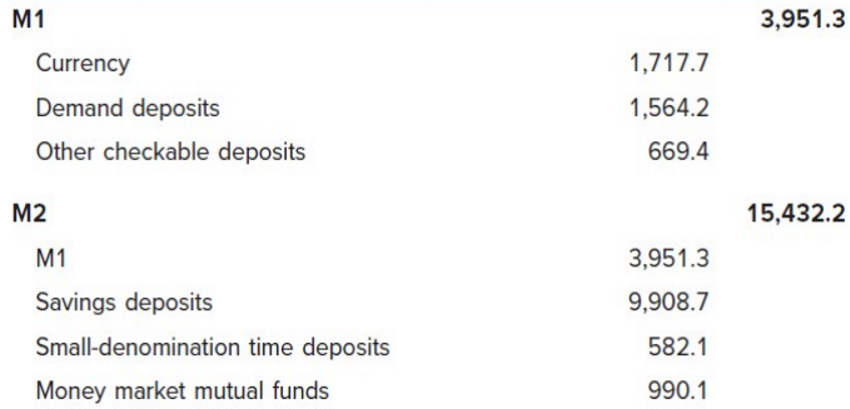
Demand for Money
the amount of wealth an individual chooses to hold in the form of money
Opportunity Cost of Holding Money
(i - π) - (0 - π) = i
real return on alternative assets (r = i - π) - real return to money (0 - π)
Money Demand Curve
Shows the relationship between the aggregate quantity of money demanded (M) and the nominal interest rate (i)
Because an increase in the nominal interest rate increases the opportunity cost of holding money, which reduces the quantity of money demanded, the money demand curve slopes down
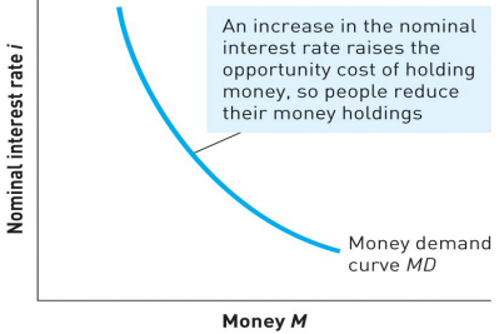
Bank Reserves
Cash or similar assets held by commercial banks used for the purpose of meeting depositor withdrawals and payments
Is Cash in a Bank’s Vault part of the Money Supply?
no it is unavailable for payments
but, bank deposits available for use in transactions are part of the money supply
100% Reserve Banking
a situation where banks reserves equal 100% of their deposits
Fractional-Reserve Banking System
a banking system in which banks hold fewer reserves than deposits so the reserve-deposit ratio is less than 100%
Desired Reserve-Deposit Ratio
bank reserves/bank deposits
Money Supply
currency held by public + bank reserves/(desired reserve-deposit ratio)
Securitisation
A practice by which banks can pool existing loans and sell them to another financial institution
Advantage: increases the supply of credit
Drawback: depends on the creditworthiness of the mortgagees and of the willingness of capital markets to hold securitized debts
The Federal Reserve
central bank of the US
Does not attempt to maximize profit
Promotes public goals such as economic growth, low inflation, and smoothly functioning financial markets
Responsibilities of the Federal Reserve
Conduct monetary policy
Oversee and regulate financial markets
Central to solving financial crises
Open-Market Operations when the Fed Purchases a Bond from the Public
Fed pays bond holder with new money
The new money enters the economy
The bond, which wasn’t money, leaves the economy
Receipts are deposited and this leads to a multiple expansion of the money supply
Open-Market Operations when the Fed Sells a Bond to the Public
Bondholder pays with checking funds
The checking funds, which were money, leave the economy
The bond, which is not money, enters the economy
Bank reserves decrease and this leads to a multiple contraction of the money supply
Increasing the Money Supply Example
An economy has 1,000 shekels in currency and bank reserves of 200 shekels
Reserve-deposit ratio = 0.2
Money supply = 1,000 + (200 / 0.2) = 2,000 shekels
Central bank pays 100 shekels for a bond held by the public
Assume that all 100 shekels are deposited
Money supply = 1,000 + (300/ 0.2) = 2,500 shekels
100 shekel increase in reserves leads to a 500 shekel increase in the money supply
Money Supply Curve
Central Bank sets the money supply at MS1
An open-market purchase increases the money supply curve to MS2
An open-market sale reduces the money supply and shifts the money supply to MS3
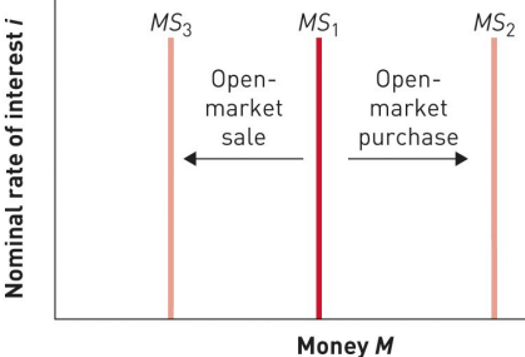
Equilibrium in the Market for Money
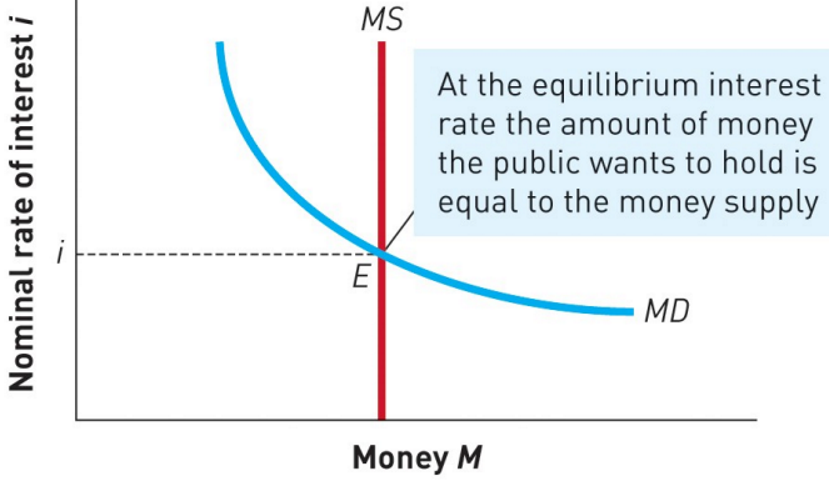
How the Central Bank Controls Nominal Interest Rate
Can lower it by increasing the money supply
For the given money demand curve, an increase in the money supply from MS to MS’ shifts the equilibrium point in the money market from E to F, lowering the nominal interest rate from i to i’
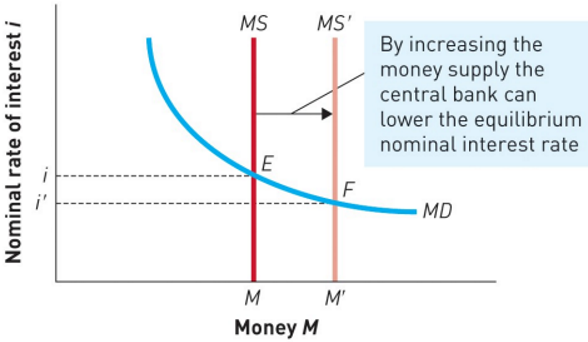
How does the Fed prevent Bank Panics?
Supervising and regulating banks
Loaning banks funds if needed
Deposit Insurance
Deposits of less than $250,000 will be repaid even if the bank is bankrupt
Decreases incentive to withdraw funds on rumours
Inflation
the price level increases rapidly, money loses value rapidly, and people become more reluctant to hold their wealth in this store of money
The Quantity Theory of Money
How the price level is determined and why it might change over time
The quantity of money available in the economy determines the value of money
The primary cause of inflation is the growth in the quantity of money
Inflation results when the money supply rises faster than the supply of goods and services
Nominal Variables
measured in monetary units
Real Variables
measured in physical units
The Quantity Equation
shows that an increase in the quantity of money in an economy must be reflected in one of three other variables:
The price level must rise,
the quantity of output must rise, or
the velocity of money must fall
What will happen if People start Hoarding Cash/Saving more Money than Spending it?
the velocity of money will decrease which can lead to a decrease in overall economic activity as fewer transactions are taking place
What happens when the Fed changes the Quantity of Money?
it causes proportionate changes in the nominal value of output (P x Y)
because it’s neutral, it doesn’t affect output
Monetary Neutrality
the irrelevance of monetary changes for real variables
changes in the money supply affect nominal variables but not real variables
Velocity of Money (V)
A measure of the speed at which money changes hands in transactions for final goods and services
Velocity of Money Formula
(P x Y) / M
P x Y = Nominal GDP (Price Level x Real GDP)
M = Money Stock
What is a Higher Velocity a sign of?
the same amount of money id being used for a number of transactions
indicates a high degree of inflation
What is Velocity Determined by?
a number of factors including technology such as ATMs and debit cards
these technologies allow people to conduct business while carrying less cash
The Inflation Tax
a tax on everyone who holds money caused by governments raising revenue by printing more money
in the form of a reduction in the value of money holding which erodes purchasing power
individuals and businesses need to pay more money to purchase the same amount of goods and services
Fiscal Theory of Price Level (FTPL)
Argues that the price level in an economy is ultimately determined by the government's budget decisions, rather than by the quantity of money in circulation, as in the quantity theory of money
According to the FTPL, fiscal policy dominates monetary policy in determining the price level
Changes in government spending and taxation have a greater impact on the price level than changes in the money supply
Deficits may cause governments to inflate away the debt as the real amount it must pay is smaller
Commodity Money
any money made up of precious metals or another valuable commodity
inconvenient - very hard and heavy to transport from one place to another
Fiat Money
paper currency that isn’t convertible into or tied to any commodity but that the government still declares as legal tender
can be printed and changed at will and its value becomes determined by market forces
Cryptocurrencies
a digital asset designed to be a medium of exchange
Central Bank Digital Currencies (CBDC)
inspired by Bitcoin
potential advantages - fast, secure, reduce transaction costs, reduce rents, provide information (tax collection), enable negative nominal interest rates
drawbacks - untested in periods of crisis, might affect monetary policy transmission, lots of power concentrated in the central bank